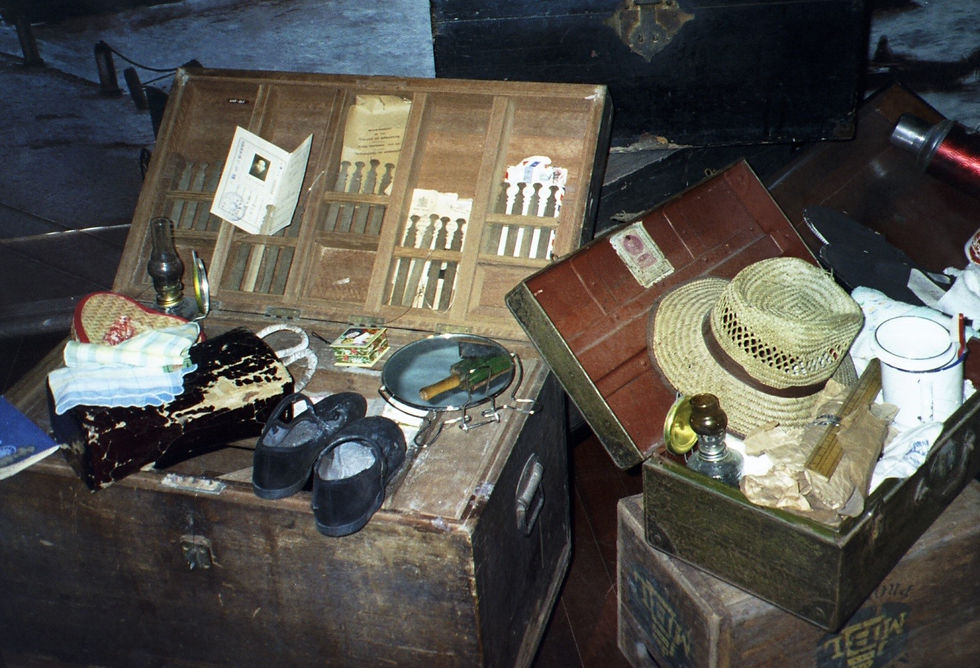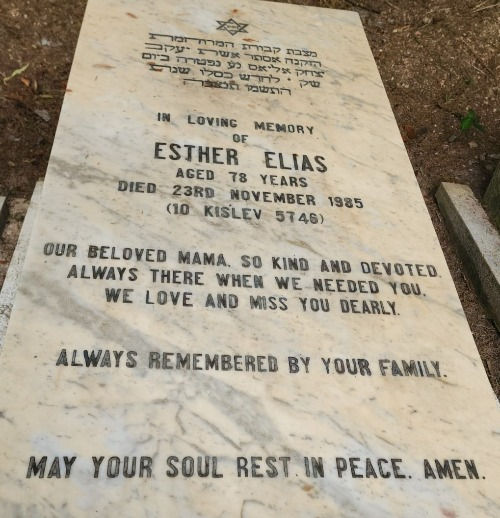Water Migrant
- Jay Prosser
- Jan 27, 2024
- 6 min read
Updated: Dec 30, 2025

My grandmother had a lifelong association with water. She was also twice a refugee, or what would now be called an illegal immigrant.
My grandmother Sim Koh-wei was just days old when she was laid in a basket by the side of the Han Jiang, close to where this river meets the South China Sea. A fisherman-farmer found her. It sounds like the beginning of a fairy tale, I know, but this most watery, fennish part of China straddles worlds. Life is amphibious here. Lotus roots and lotus flowers, crabs and bamboo shoots, all thrive between land and water. Fish were farmed alongside vegetables in pools at the edges of rice fields, in baskets like that Koh-wei was found in. And once the fisherman-farmer had seen her in that basket woven of wicker rushes, just like the ones he used to fatten fish and grow vegetables, he knew she was destined to be his daughter. He took her home and raised her, a fairy godfather become her beloved foster father.
We don’t know why she was given up or by whom. She had smallpox, which is contagious, and which slightly marked her skin. Then again, in China, in the last days of the Qing Empire (it was 1909), families didn’t need many reasons to give up a girl. Daughters meant having to raise money for a dowry. And then when they married, daughters were always considered to have married out, that is, outside the patriarchy.
Her fisherman-farmer foster-father told Koh-wei that she came from a wealthy, aristocratic family. She was a rich girl disguised as a poor girl. With this adoptee’s dream, he gave her a template for her life, a story of magical transformation. She could be or become anything. Transition. But he brought her up and loved her as his own, a fisherman-farmer’s daughter. She never spoke of a foster mother.
They lived in a poor tenant quarter, close to the river, in the city of Chaozhou. Chaozhou, meaning ‘city of tides’. An apt name. Chaozhou seemed to move, to fluctuate, as it shifted between the provinces of Fujian and Guangdong, whose border was repeatedly redrawn. This is the area in China that has been most shaped by migration. A flotsam of traders, settlers and missionaries flowed in – Thais, Vietnamese, Spanish, Portuguese, British. A jetsam of mostly desperate migrants flowed out. It’s a startling fact that, today, most diaspora Chinese, most Chinese communities outside China, can trace their origin story to just these two provinces, and many to Chaozhou.
In Koh-wei’s day, the city of Chaozhou had no bridge. So the inhabitants crossed the Han Jiang by a span of wooden punts, strung together in a long, mobile chain. When she crossed the bridge of boats, Koh-wei felt the rise and fall of the river under her tread. The water seeped up and entered her skin.
City of Tides.
Koh-wei was sent by her father to trade their fish and vegetables at the nearby port. Down by the seafront, she saw sampans offloading the catch from large fishing junks. Men grappled giant grouper, silver sea bream, red mullet, flatfish, eels. Closer to the shore, she watched paddling women as they scooped sea slugs, sea cucumbers, crabs, lobster and shrimp. Absorbing it all, she set up her wares. Carp, thin purple aubergines, yard-long beans - all in familiar wicker baskets.
In her early twenties, Koh-wei lost her father. Probably around the same time, she got married. She needed to marry now, in order to survive. Her husband couldn’t afford a dowry. Together they worked the land. She had one daughter, Poh-kim. The day of the birth, Koh-wei returned to work the fields, her baby strapped to her back.
Within a couple of years, her husband had died. With a child, no husband and no father anymore, Koh-wei and her daughter were in danger of starvation. China was in perhaps its period of greatest chaos. The empire had melted away and now the new republic was dissolving. The Japanese had invaded southeast China and were making their headquarters nearby. Civil war between nationalists and communists was further tearing the country apart. In 1935, Mao began his Long March, from Fujian to the northern provinces. Following the waves of migration preceding her, Koh-wei decided she had to get out. She would go to Nanyang, ‘Southern Ocean.’ To an island a thousand miles southwest over the South China Sea, where there was said to be work, but that was close enough to return home. Singapore.
Her in-laws wouldn’t allow her to take the child, whether out of love or because they wanted to use Poh-kim as some kind of slave, no one knows. Like most other migrants/refugees, Koh-wei planned to return home. She was going only to earn money to send home; only to work until things got better; only until home changed.
She decided on Singapore soon after the British colonial government had passed an Aliens Ordinance (1933), designed to limit immigration from China. Struck with immigration panic (a recurrent condition) and a bout of ‘yellow peril’ (sounds antiquated now but there are contemporary equivalents), the British were repatriating large numbers of immigrant Chinese from Singapore. Koh-wei went against the tide. She engaged someone she thought of as a helper - not a smuggler - to arrange her boat journey and help her transition to her new life. This person was called a ‘sui haak,’ literally a ‘water guest’: another intercessor between worlds.

The steamer from Fujian to Singapore took about ten days. As with all refugee journeys, the boat was overcrowded. Koh-wei shared a room below deck with several other women and children. The heat was stifling and there were no beds. Twice a day she received a small bowl of rice, a little sauce, sometimes a little fish, and by the end of the journey there were no vegetables. Men’s and women’s toilets were simply opposite sides of the ship. Many passengers became sick, infected with lice, cholera, TB. A few – some old, some weak, a child – died. Their bodies were thrown overboard.
In Singapore, Koh-wei was lucky to find work with a Baghdadi Jewish spice merchant, Jacob Isaac Ezekiel Hyeem Elias: my grandfather. She looked after the children of this widower. She lived with the family as a ma-jie, a Chinese ah-ma or nanny, a role key to raising colonial children in 1930s Southeast Asia. In the photograph above, the first photograph we have of them together, my grandparents look like what they were - a Chinese servant and a Middle Eastern merchant. But that relationship soon changed, and my mother, the little girl on her father’s lap in the middle of this photo, and her sister, the baby on her mother’s lap, were proof of the growing love. Koh Wei became Jacob’s Esther. Esther Elias. She took his last name, and he gave her a new first name.
In 1942, Esther Elias found herself taking another boat journey, fleeing another burning city. The family got the last boat before the Japanese invaded and occupied Singapore. As the Felix Roussel zigzagged its way to Bombay, dodging the bombs and strafing from Japanese planes, did Esther/Koh-wei think back to her previous near escape? She was the only Chinese woman on board the Felix Roussel, and the couple were not yet legally married. I cannot fathom how she managed to get away again.
When the family returned to Singapore in 1946, my mother remembers her mother opening a letter from China. It said that Poh-kim had died. ‘It was the first time I saw her cry,’ my mother says ‘- and the first time I realised she had another daughter.’
Esther formally converted to Judaism when my grandparents, both now elderly, were finally granted a Jewish wedding in the 1960s. But she had been living a Jewish life long before that, almost since she met Jacob, and she had quickly become a more observant Jew than he ever was. In the 1970s, after Jacob died, Esther migrated to America, not by boat this time, and not illegally, to live in very landlocked Dallas with some of her daughters. When she knew she was nearing her own death, she told her children, ‘I want to return to Singapore. I want to be buried in the Jewish cemetery, with your father.’
And so it happened. Her Jewish funeral was one of the best attended in Singapore.
The Chinese have a saying that the falling leaf returns to its root. But this is not the end of my grandmother’s plot. Her plot is in the Jewish cemetery with my grandfather in Singapore. This is, and is not, my grandmother’s home. She is still migrating, still straddling worlds. For those at sea, for those who have to flee, home is never single or simple.



